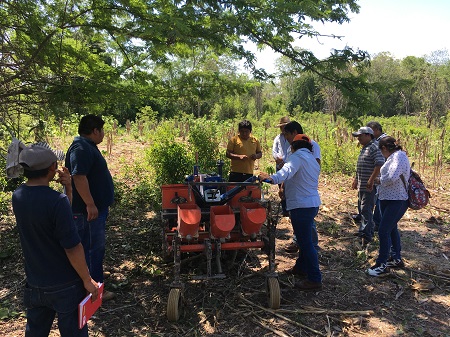
TEXCOCO, Mexico (CIMMYT) – Farmers in Mexico’s ecologically-fragile Yucatán Peninsula are beginning to adopt innovative practices to manage traditional mixed-cropping systems called “milpas” that can slow or even stop deforestation and soil degradation.
Agriculture is the second largest emitter of global greenhouse gas emissions and largest driver of deforestation, making the sector one of the top contributors to climate change and biodiversity loss.
Fifteen percent of global emissions is due mostly to agricultural expansion into tropical forests. Rising populations and changes in dietary preferences for more energy intense foods, like beef and soy bean, are expected to boost agricultural emissions a further 15 percent by 2030.
Agricultural expansion and resulting deforestation of tropical areas also threatens more than half of all the world’s plant and animal species, contributing significantly to what many scientists say is Earth’s sixth mass extinction.
“Sustainable agriculture can bring large benefits to tropical areas by optimizing land use while improving farm management and techniques for farmers,” said Jelle Van Loon, a mechanization expert at the International Maize and Wheat Improvement Center (CIMMYT) who is working with farming communities in Mexico’s Yucatán Peninsula – an area compromising much of the largest remaining tropical rainforest in the Americas after the Amazon.
Nearly 80 percent of vegetation has been deforested or degraded in the peninsula, with more than 80,000 hectares being cut down annually.
“Agriculture in the Yucatán Peninsula is extremely diverse – there’s everything from industrial farms that operate around forest areas to small community farmers practicing the traditional milpa system in the interior,” said Van Loon.
Milpa farming – a traditional mixed-cropping system in which maize, beans and squash are grown – contributes to about 16 percent of deforestation in the region, and is typically practiced by subsistence farmers through slash and burn agriculture.
“Milpa systems vary across communities in the region,” said Van Loon. “Sometimes plots are burned, farmed and left within two to three years for a new plot, and others are more permanent.”

Van Loon is working with a team of CIMMYT scientists and other partners in the region to see how farmers can apply sustainable technologies and practices across the peninsula’s milpa systems, as well as larger-scale mechanized farms that operate in the area.
“It’s extremely important that the unique circumstances of each community are taken into account when new technologies are being promoted,” said Van Loon, citing that many programs exist to support local communities, but is often challenging to organize support in an integrated fashion that’s adjusted to local conditions.
“Milpa provides more than crops for food – the slash and burn system also provides game and timber for these communities, so there are many factors that need to be taken into account when we try and promote sustainable practices.”
Two years ago CIMMYT successfully trialed a sustainable agriculture initiative with farmers in Hopelchén, a small community in Campeche where indigenous and Mennonite farmers grow maize following traditional farming practices.
Decades of soil degradation had forced farmers to convert rainforest areas into growing fields to continue farming, but when the farmers adopted sustainable intensification methods such as minimal soil movement, surface cover of crop residues and crop rotations, they were able to achieve higher yields even after two months of drought.
The Hopelchén farmers prove the dual benefits of sustainable agriculture in forest areas – forests that would otherwise have been cut down for farmland are preserved, acting as a ‘carbon sink’ by absorbing carbon dioxide that would have been free in the atmosphere, further contributing to climate change. These practices also help farmers adapt to the effects of climate change, like drought and erratic rainfall.
“In order to get adoption right, we are really taking a system-wide approach,” said Van Loon. “We want to integrate mechanization, soil quality, planting density and other approaches like inter-planting with trees to improve biodiversity to get the most efficient system possible.” Van Loon will specifically work with communities to explore mechanization opportunities, from improved hand tools to light weight motorized equipment like two-wheel tractors.
“The goal is to optimize the benefits from the land that farmers are working, find ways to reduce pressure on opening new land and as such slow the rate of deforestation, preserve biodiversity and provide farmers with techniques for improved and more sustainable practices,” said Van Loon. “Ultimately, we’d like to see these practices adopted across the peninsula.”
CIMMYT is leading sustainable intensification efforts in the Yucatan through the Sustainable Modernization of Traditional Agriculture (MasAgro) program, along with CitiBanamex, Fundación Haciendas del Mundo Maya, local partners, non-governmental organizations and the Mexican government.
 Capacity development
Capacity development 
